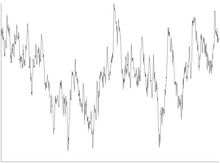Noise (electronics)
Thermal noise is approximately white, meaning that its power spectral density is nearly equal throughout the frequency spectrum.Vacuum tubes exhibit shot noise because the electrons randomly leave the cathode and arrive at the anode (plate).A tube may not exhibit the full shot noise effect: the presence of a space charge tends to smooth out the arrival times (and thus reduce the randomness of the current).Pentodes and screen-grid tetrodes exhibit more noise than triodes because the cathode current splits randomly between the screen grid and the anode.Shot noise has been demonstrated in mesoscopic resistors when the size of the resistive element becomes shorter than the electron–phonon scattering length.Burst noise consists of sudden step-like transitions between two or more discrete voltage or current levels, as high as several hundred microvolts, at random and unpredictable times.Thermal noise can be reduced by cooling of circuits - this is typically only employed in high accuracy high-value applications such as radio telescopes.In a digital communications system, a certain Eb/N0 (normalized signal-to-noise ratio) would result in a certain bit error rate.Integrated circuit devices, such as operational amplifiers commonly quote equivalent input noise level in these terms (at room temperature).
electromagnetic compatibilityelectromagnetic interferenceelectromagnetically induced acoustic noise and vibrationNoise (disambiguation)pink noiseelectronicsthermodynamicselectrical resistancecryogenicallyquantum noisenoise in signal processingcommunication systemssignalcommunication channelinterferencesignal-to-noise ratiosignal-to-interference ratiosignal-to-noise plus interference ratiodistortionsignal-to-noise and distortion ratiototal harmonic distortion plus noiserandom number generationditherUncorrelated noiseThermal noisefluctuation-dissipation theoremshot noisesemiconductor1/f noiseJohnson–Nyquist noiseelectronselectrical conductorvoltagepower spectral densityfrequency spectrumGaussian probability density functionadditive white Gaussian noiseelectric currentVacuum tubesspace chargePentodestetrodestriodesthermalizeFlicker noiseBurst noisemicrovoltsinductive couplingcapacitive couplingantennaradio receiverIntermodulationCrosstalkAtmospheric noiselightningcorona dischargefluorescent lampsradiationsolar stormssolar cycleCosmic noisecommunications systemshydrogen lineFaraday cageground loopsshielded cableTwisting wiresband-rejection filtersline frequencyroot mean squarestandard deviationmean squared errorprobability distributionnoise spectral densitysignal-to-quantization noise ratioanalog-to-digital conversionpeak signal-to-noise rationoise figurecarrier-to-noise ratiobit error ratestochasticvariancedistributionspectral densityfrequencyresistive elementIntegrated circuitoperational amplifiersequivalent input noisequantisation errorstochastic resonanceActive noise controlColors of noiseDiscovery of cosmic microwave background radiationError detection and correctionGeneration–recombination noiseMatched filterNoise (signal processing)Noise reductionPhonon noisejammingBibcodepublic domain materialGeneral Services AdministrationMIL-STD-188Wayback MachineAcoustic quietingNoise cancellationNoise controlNoise measurementNoise powerNoise temperaturePhase distortionBuildingsEnvironmentGovernment regulationHuman healthImagesSound maskingTransportationBackground noiseBrownian noiseGaussian noiseGrey noiseInfrasoundJitter